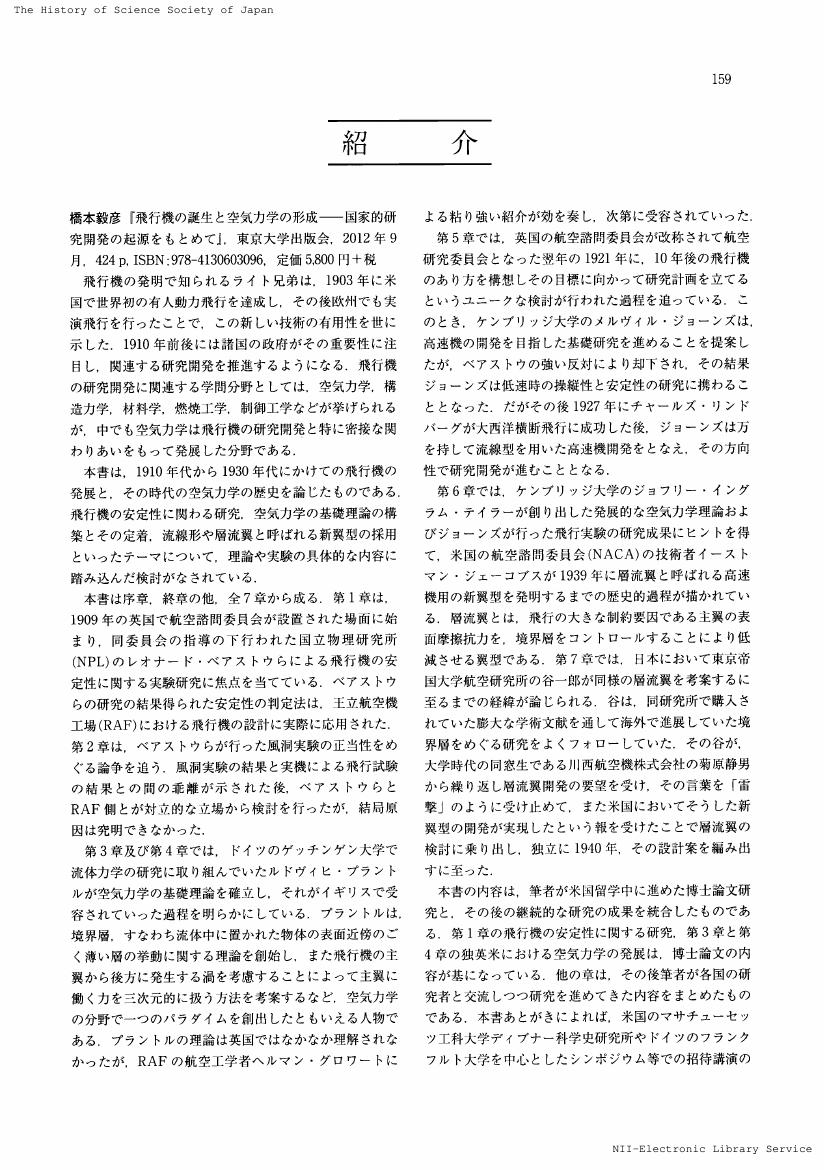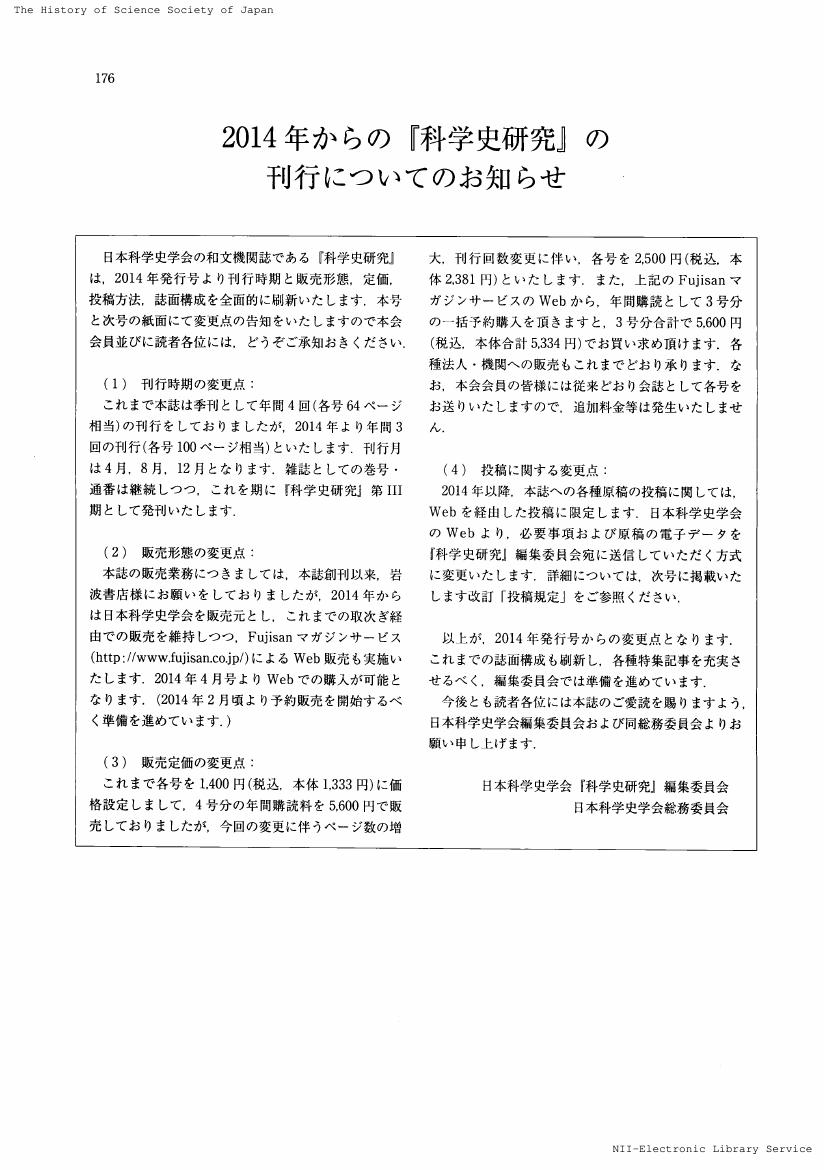1 0 0 0 OA 史料としての「編輯後記」
- 出版者
- 日本科学史学会
- 雑誌
- 科学史研究 (ISSN:21887535)
- 巻号頁・発行日
- vol.52, no.268, pp.249-254, 2013 (Released:2021-07-12)
1 0 0 0 OA 2014年からの『科学史研究』の刊行についてのお知らせ(第2報)
- 出版者
- 日本科学史学会
- 雑誌
- 科学史研究 (ISSN:21887535)
- 巻号頁・発行日
- vol.52, no.268, pp.256, 2013 (Released:2021-07-12)
- 著者
- 小林 昭三 興治 文子
- 出版者
- 日本科学史学会
- 雑誌
- 科学史研究 (ISSN:21887535)
- 巻号頁・発行日
- vol.52, no.268, pp.200-210, 2013 (Released:2021-07-12)
- 被引用文献数
- 1
We found varieties of students' notebooks on science in Middle Meiji Era(MME) in various regions of Japan. By investigating these historically valuable primary documents, i. e. "Buturi Hikki and Kagaku Hikki", we gained a deep insight into Japanese science education and clarified those real situations in MME. We also revealed what and how science was taught by using science text books and experimental tools shown in those notebooks in MME. Especially important results of those are verification of the real usage of the "Shogakko Seitoyo Butsurisho" "Physics for Elementary School" Students in English, by various note or memo written by pupils (or teachers) of primary school of Niigata, Saitama, Gunma, etc. in 1885-1897 of MME. Furthermore, we found how Japanese teachers developed their own styles of science teaching based on Japanese culture and how they cached up to the top level of the worlds by worldwide connections and by using hands-on tools in MME for learning actively.
- 著者
- 佐藤 賢一
- 出版者
- 日本科学史学会
- 雑誌
- 科学史研究 (ISSN:21887535)
- 巻号頁・発行日
- vol.52, no.267, pp.129-133, 2013 (Released:2021-07-12)
- 著者
- 松原 洋子
- 出版者
- 日本科学史学会
- 雑誌
- 科学史研究 (ISSN:21887535)
- 巻号頁・発行日
- vol.52, no.267, pp.134-143, 2013 (Released:2021-07-12)
- 著者
- 和文誌編集委員会
- 出版者
- 日本科学史学会
- 雑誌
- 科学史研究 (ISSN:21887535)
- 巻号頁・発行日
- vol.52, no.267, pp.144-148, 2013 (Released:2021-07-12)
1 0 0 0 OA 第7回日本科学史学会賞の報告
- 出版者
- 日本科学史学会
- 雑誌
- 科学史研究 (ISSN:21887535)
- 巻号頁・発行日
- vol.52, no.267, pp.149-152, 2013 (Released:2021-07-12)
1 0 0 0 OA 第60回日本科学史学会年会・総会報告
- 出版者
- 日本科学史学会
- 雑誌
- 科学史研究 (ISSN:21887535)
- 巻号頁・発行日
- vol.52, no.267, pp.153-158, 2013 (Released:2021-07-12)
1 0 0 0 OA 紹介
- 出版者
- 日本科学史学会
- 雑誌
- 科学史研究 (ISSN:21887535)
- 巻号頁・発行日
- vol.52, no.267, pp.159-162, 2013 (Released:2021-07-12)
1 0 0 0 OA 2014年からの『科学史研究』の刊行についてのお知らせ
- 出版者
- 日本科学史学会
- 雑誌
- 科学史研究 (ISSN:21887535)
- 巻号頁・発行日
- vol.52, no.267, pp.176, 2013 (Released:2021-07-12)
- 著者
- 由井 秀樹
- 出版者
- 日本科学史学会
- 雑誌
- 科学史研究 (ISSN:21887535)
- 巻号頁・発行日
- vol.52, no.268, pp.177-186, 2013 (Released:2021-07-12)
Little is known about the meaning of medical intervention in the area of male infertility in Japan. In order to investigate this issue, this paper analyzes the topic through a review of professional journals for obstetricians and gynecologists in Japan from the mid-1930s to the mid-1950s. The paper shows how artificial insemination by donor (AID) was introduced into the study of obstetrics and gynecology in Japan as a part of male infertility studies. The research clarifies four main points. First, the introduction of AID by Ando Kakuichi, who was an obstetrician and gynecologist at Keio University was related to contraception studies; due to the rapid population increase at the time, contraception studies were encouraged. Second, although there had been little investigation into male infertility problems until World War II, Ando regarded male infertility as an important issue and introduced AID after the war. Third, some obstetricians and gynecologists were opposed to AID; at Keio University, AID was seen as the last resort for male infertility, and in the mid-1950s, in order to obviate the need for AID as far as possible, new male fertility tests were developed, and ways to help sperm recover their viability were published. Fourth, after the introduction of AID by Ando, male infertility studies were also developed at other universities and they formed an important subject in the field. Consequently, not only the female body but also the male body became an object of intervention in obstetrics and gynecology in Japan.
1 0 0 0 OA 紹介
- 出版者
- 日本科学史学会
- 雑誌
- 科学史研究 (ISSN:21887535)
- 巻号頁・発行日
- vol.52, no.265, pp.29-36, 2013 (Released:2021-07-14)
1 0 0 0 OA 紹介
- 出版者
- 日本科学史学会
- 雑誌
- 科学史研究 (ISSN:21887535)
- 巻号頁・発行日
- vol.52, no.266, pp.101-102, 2013 (Released:2021-07-12)
1 0 0 0 OA 日本の戦時科学技術体制
- 著者
- 水沢 光
- 出版者
- 日本科学史学会
- 雑誌
- 科学史研究 (ISSN:21887535)
- 巻号頁・発行日
- vol.52, no.266, pp.65-69, 2013 (Released:2021-07-12)
- 著者
- 水沢 光
- 出版者
- 日本科学史学会
- 雑誌
- 科学史研究 (ISSN:21887535)
- 巻号頁・発行日
- vol.52, no.266, pp.70-80, 2013 (Released:2021-07-12)
In World War II, when Japan was under a scientific blockade, the Ministry of Education provided a science and technology information service, such as summary reports of foreign journals and translations of foreign books. The information service covered a wide area of scientific investigation. Although the Japanese government advocated an emphasis on wartime research at its August 1943 Cabinet meeting, the Ministry of Education continued to expand the information service. Previous studies give no details on how these science-promoting measures were adopted in wartime. This paper, using the Inumaru Records in Japan's National Diet Library, reveals that the information service started and expanded through a loose coalition between scientists and Ministry of Education officials. Inumaru Hideo( 1904-1990) was a Ministry of Education official who took charge of the information service. In August 1942, the Ministry started a summary reports service for German academic journals in response to scientist complaints about the blockade. The Ministry left the choice of journals up to scientists, and the reports service continued to expand until late 1944. In July 1943, the Ministry started a translation project for foreign books, addressing a decline in students' academic ability resulting from a cut in higher-education requirements. In the project, textbooks in various fields translated into Japanese, and the translation project continued after the war.
1 0 0 0 OA 欧州における低エネルギー建築技術の発達
- 著者
- 詫間 直樹 中島 秀人
- 出版者
- 日本科学史学会
- 雑誌
- 科学史研究 (ISSN:21887535)
- 巻号頁・発行日
- vol.52, no.266, pp.81-91, 2013 (Released:2021-07-12)
The Fukushima Daiichi Nuclear Disaster has revealed the huge potential risk inherent in nuclear power generation. It adds very much to the existing energy problems such as depletion of fuels and global warming. To achieve substantial reduction in both fossil and nuclear energy, not only the enhancement of renewable energy on the supply-side but also the suppression of energy consumption on the demand-side would be required. Low-energy building technology is considered an effective means of energy consumption reduction. EU is the front-runner of this field, in terms of the level of technology, the adequacy of regulation, and the degree of diffusion. This implies that the development of low-energy building technology in Europe is worth historical study. With regard to historiography, we emphasize the complex nature of technological developments. It is not a linear, steady process. It turns and twists. A technological path is a result of aggregation of interactions - either conflicts or collaborations - among a variety of heterogeneous actors. Such complexity and heterogeneity often enrich the quality of technological development, according to the debates on the "resistance to new technologies " and the "unlocking of technological trajectories ". We also indicate some historical lessons such as the role of new entrants, the necessity of nurturing space for innovation, and the importance of sharing the basic concept of the technology among related actors.
1 0 0 0 OA 「石塚六郎兵衛算術」 : 和算家の算術修行日記
- 著者
- 佐藤 賢一
- 出版者
- 日本科学史学会
- 雑誌
- 科学史研究 (ISSN:21887535)
- 巻号頁・発行日
- vol.52, no.266, pp.92-100, 2013 (Released:2021-07-12)
1 0 0 0 OA フィールド・サイエンスの科学史,2012年度年会報告
1 0 0 0 OA 紹介
- 出版者
- 日本科学史学会
- 雑誌
- 科学史研究 (ISSN:21887535)
- 巻号頁・発行日
- vol.51, no.264, pp.253, 2012 (Released:2021-07-20)
1 0 0 0 OA 蒸気機関技術史概論
- 著者
- 小林 学
- 出版者
- 日本科学史学会
- 雑誌
- 科学史研究 (ISSN:21887535)
- 巻号頁・発行日
- vol.52, no.265, pp.1-4, 2013 (Released:2021-07-14)















